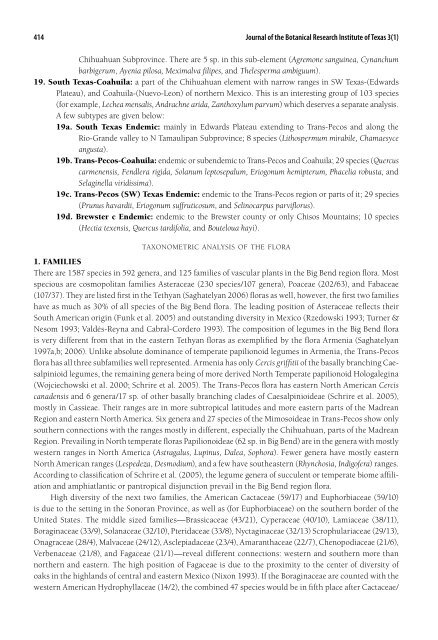Anna Saghatelyan - Botanical Research Institute of Texas
Anna Saghatelyan - Botanical Research Institute of Texas
Anna Saghatelyan - Botanical Research Institute of Texas
Create successful ePaper yourself
Turn your PDF publications into a flip-book with our unique Google optimized e-Paper software.
414 Journal <strong>of</strong> the <strong>Botanical</strong> <strong>Research</strong> <strong>Institute</strong> <strong>of</strong> <strong>Texas</strong> 3(1)<br />
Chihuahuan Subprovince. There are 5 sp. in this sub-element (Agremone sanguinea, Cynanchum<br />
barbigerum, Ayenia pilosa, Meximalva filipes, and Thelesperma ambiguum).<br />
19. South texas-Coahuila: a part <strong>of</strong> the Chihuahuan element with narrow ranges in SW <strong>Texas</strong>-(Edwards<br />
Plateau), and Coahuila-(Nuevo-Leon) <strong>of</strong> northern Mexico. This is an interesting group <strong>of</strong> 103 species<br />
(for example, Lechea mensalis, Andrachne arida, Zanthoxylum parvum) which deserves a separate analysis.<br />
A few subtypes are given below:<br />
19a. South texas Endemic: mainly in Edwards Plateau extending to Trans-Pecos and along the<br />
Rio-Grande valley to N Tamaulipan Subprovince; 8 species (Lithospermum mirabile, Chamaesyce<br />
angusta).<br />
19b. trans-Pecos-Coahuila: endemic or subendemic to Trans-Pecos and Coahuila; 29 species (Quercus<br />
carmenensis, Fendlera rigida, Solanum leptosepalum, Eriogonum hemipterum, Phacelia robusta, and<br />
Selaginella viridissima).<br />
19c. trans-Pecos (SW) texas Endemic: endemic to the Trans-Pecos region or parts <strong>of</strong> it; 29 species<br />
(Prunus havardii, Eriogonum suffruticosum, and Selinocarpus parviflorus).<br />
19d. Brewster c Endemic: endemic to the Brewster county or only Chisos Mountains; 10 species<br />
(Hectia texensis, Quercus tardifolia, and Bouteloua kayi).<br />
t a x o n o m e t r i c an a l y s i s <strong>of</strong> th e fl o r a<br />
1. FaMiliES<br />
There are 1587 species in 592 genera, and 125 families <strong>of</strong> vascular plants in the Big Bend region flora. Most<br />
specious are cosmopolitan families Asteraceae (230 species/107 genera), Poaceae (202/63), and Fabaceae<br />
(107/37). They are listed first in the Tethyan (<strong>Saghatelyan</strong> 2006) floras as well, however, the first two families<br />
have as much as 30% <strong>of</strong> all species <strong>of</strong> the Big Bend flora. The leading position <strong>of</strong> Asteraceae reflects their<br />
South American origin (Funk et al. 2005) and outstanding diversity in Mexico (Rzedowski 1993; Turner &<br />
Nesom 1993; Valdés-Reyna and Cabral-Cordero 1993). The composition <strong>of</strong> legumes in the Big Bend flora<br />
is very different from that in the eastern Tethyan floras as exemplified by the flora Armenia (<strong>Saghatelyan</strong><br />
1997a,b; 2006). Unlike absolute dominance <strong>of</strong> temperate papilionoid legumes in Armenia, the Trans-Pecos<br />
flora has all three subfamilies well represented. Armenia has only Cercis griffitii <strong>of</strong> the basally branching Caesalpinioid<br />
legumes, the remaining genera being <strong>of</strong> more derived North Temperate papilionoid Hologalegina<br />
(Wojciechowski et al. 2000; Schrire et al. 2005). The Trans-Pecos flora has eastern North American Cercis<br />
canadensis and 6 genera/17 sp. <strong>of</strong> other basally branching clades <strong>of</strong> Caesalpinioideae (Schrire et al. 2005),<br />
mostly in Cassieae. Their ranges are in more subtropical latitudes and more eastern parts <strong>of</strong> the Madrean<br />
Region and eastern North America. Six genera and 27 species <strong>of</strong> the Mimosoideae in Trans-Pecos show only<br />
southern connections with the ranges mostly in different, especially the Chihuahuan, parts <strong>of</strong> the Madrean<br />
Region. Prevailing in North temperate floras Papilionoideae (62 sp. in Big Bend) are in the genera with mostly<br />
western ranges in North America (Astragalus, Lupinus, Dalea, Sophora). Fewer genera have mostly eastern<br />
North American ranges (Lespedeza, Desmodium), and a few have southeastern (Rhynchosia, Indig<strong>of</strong>era) ranges.<br />
According to classification <strong>of</strong> Schrire et al. (2005), the legume genera <strong>of</strong> succulent or temperate biome affiliation<br />
and amphiatlantic or pantropical disjunction prevail in the Big Bend region flora.<br />
High diversity <strong>of</strong> the next two families, the American Cactaceae (59/17) and Euphorbiaceae (59/10)<br />
is due to the setting in the Sonoran Province, as well as (for Euphorbiaceae) on the southern border <strong>of</strong> the<br />
United States. The middle sized families—Brassicaceae (43/21), Cyperaceae (40/10), Lamiaceae (38/11),<br />
Boraginaceae (33/9), Solanaceae (32/10), Pteridaceae (33/8), Nyctaginaceae (32/13) Scrophulariaceae (29/13),<br />
Onagraceae (28/4), Malvaceae (24/12), Asclepiadaceae (23/4), Amaranthaceae (22/7), Chenopodiaceae (21/6),<br />
Verbenaceae (21/8), and Fagaceae (21/1)—reveal different connections: western and southern more than<br />
northern and eastern. The high position <strong>of</strong> Fagaceae is due to the proximity to the center <strong>of</strong> diversity <strong>of</strong><br />
oaks in the highlands <strong>of</strong> central and eastern Mexico (Nixon 1993). If the Boraginaceae are counted with the<br />
western American Hydrophyllaceae (14/2), the combined 47 species would be in fifth place after Cactaceae/



